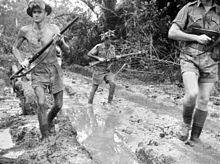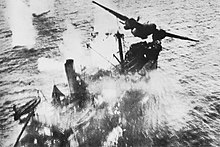
South West Pacific theatre of World War II
Theatre of World War II / From Wikipedia, the free encyclopedia
Dear Wikiwand AI, let's keep it short by simply answering these key questions:
Can you list the top facts and stats about South West Pacific theatre of World War II?
Summarize this article for a 10 years old
The South West Pacific theatre, during World War II, was a major theatre of the war between the Allies and the Axis. It included the Philippines, the Dutch East Indies (except for Sumatra), Borneo, Australia and its mandate Territory of New Guinea (including the Bismarck Archipelago) and the western part of the Solomon Islands. This area was defined by the Allied powers' South West Pacific Area (SWPA) command.
|
_underway_off_Tulagi%2C_circa_7_August_1942.jpg/220px-HMAS_Canberra_(D33)_underway_off_Tulagi%2C_circa_7_August_1942.jpg)




.jpg/220px-Balikpapan_landing_(AWM_018812).jpg)
In the South West Pacific theatre, Japanese forces fought primarily against the forces of the United States and Australia. New Zealand, the Netherlands (mainly the Dutch East Indies), the Philippines, United Kingdom, and other Allied nations also contributed forces.
The South Pacific became a major theatre of the war following the Japanese attack on Pearl Harbor in December 1941. Initially, US war plans called for a counteroffensive across the Central Pacific, but this was disrupted by the loss of battleships at Pearl Harbor. During the First South Pacific Campaign, US forces sought to establish a defensive perimeter against additional Japanese attacks. This was followed by the Second South Pacific Campaign, which began with the Battle of Guadalcanal.